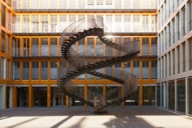
Even the locals don’t recognise some of the public art in Munich – despite the fact that they walk past it every day. Here are six works of art that are often only discovered at second glance.
Want to be able to see a work by Ólafur Elíasson any time, free of charge? You can do just that in Munich’s Westend district. This area is home to the “endlose Treppe” (endless staircase), located in an inner courtyard at 29 Ganghoferstrasse. The official title of this piece by the Icelandic-Danish artist is “Umschreibung”, which means “circumscription”, and since 2004 it has been open to anyone who wishes to admire it, installed in the rear courtyard at the premises of professional services company KPMG. The staircase is nine metres tall and leads nowhere, as it is a closed loop. That means that as soon as you got to the top, you would automatically start coming back down again. Although visitors are not permitted to climb the structure, photographs are allowed!
Between the HFF (University of Television and Film Munich) and the TU (Technical University) there hangs a piece of art at a dizzying height: a suspended basketball hoop created by wood carver Benjamin Bergmann, who himself studied at the Academy of Fine Arts in Munich. The piece, entitled “Never ever”, is about failure and success – and as such the roof of an elite university is perhaps the perfect location for it. Suspended high above Barer Strasse, not only is the basketball hoop positioned at an unreachable height; it is also upside down – so there’s really no chance of scoring a basket. The artist says: “For me, the beautiful thing about absurdity is the sustainability of confusion. Sometimes you catch yourself thinking that a completely absurd world could perhaps be much more beautiful.”
Georg Elser was a resistance fighter who fought against Nazism and carried out a bomb attack against Adolf Hitler in 1939. Today, he is commemorated with a monument on the façade of a primary school in the Maxvorstadt district, just around the corner from where he lived during his time in Munich. The light installation is five metres in diameter, and is only illuminated for one minute each day – at 9.20 pm, the exact time at which the bomb in the Bürgerbräukeller detonated on that night. The memorial, designed by Frankfurt artist Silke Wagner, shows the date of the attack – 8 November 1939 – written in the form of a circle, in a style intended to represent an explosion.
At first glance it could be mistaken for a pile of newspaper pages, but in fact this artwork immortalises the White Rose pamphlets in stone, and has been in place on the ground in front of Ludwig Maximilian University since 1988. The tribute, which also includes portrait photographs and a farewell letter, appears random in nature, but is actually designed in four thematic blocks. One shows the Scholl siblings, who were arrested on 18 February 1943 after they threw pamphlets criticising the Nazi regime from the gallery in the atrium of LMU. They were imprisoned, and executed along with Christoph Probst a few days later. The atrium also contains another monument to the White Rose resistance movement, as well as a bronze bust of Sophie Scholl.
There is one guest in Café Münchner Freiheit in Schwabing who really never leaves: Helmut Fischer. The actor became famous for his TV role as “Monaco Franze – Der ewige Stenz” (the eternal dandy) in particular. The bronze statue of the beloved Munich native was produced shortly after his death in 1997, by artist Nicolai Tregor. The commemorative piece was commissioned by mayor Christian Ude, a good friend of Fischer’s. The actor’s favourite seat in the café was the obvious choice of location for the statue: this was the spot from which he could enjoy the best view of the hustle and bustle outside, in keeping with his famous phrase: “Spatzl schau, wia i schau” (Sweetheart, look like I’m looking). The artist is currently working on a second statue that will soon keep Fischer company, of director and Monaco Franze creator Helmut Dietl, who died in 2015.
If you’re paying attention as you stroll through the inner city area of Munich, you’ll spot an almost life-sized figure of a man with outspread arms balancing on a red bar at the entrance to the Kaufingertor mall – and you might get a bit of a fright, as at first you would assume it is a man who is about to jump. But in fact the figure is made of wood, by carver Stephan Balkenhol who is known for his roughly hewn wooden sculptures. The figure he carves most often is a man with a white shirt and black trousers, a representation of our current age, and one which shows no clear emotions – as such leaving plenty of scope for the observer’s impressions.